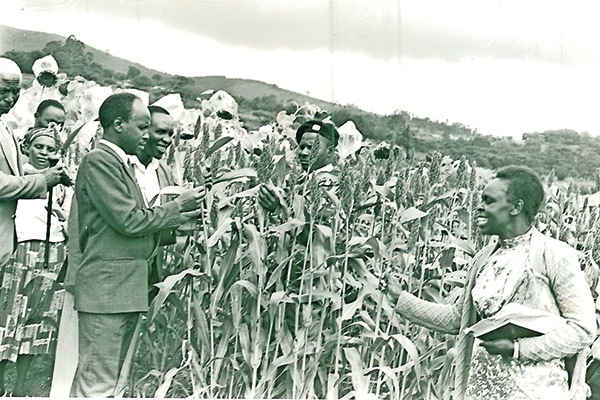Read full article by Peter Ndege@Daily Nation Photo Credit: Nation Media Group
Farmers admire healthy sorghum crop at the Ngong Agricultural Harambee Showground in the 1980s. Millet and sorghum became popular and widely grown in Kenya because of their distinct qualities, including resilience and adaptability to many climatic and soil conditions, their many uses including in the making of ugali, porridge, alcoholic drinks and in the treatment of diarrhoea and during the solemnisation of births, marriages and circumcision rituals.
In Summary
- Women particularly played a vital role in the development and spread of these crops and development of pre-colonial agriculture generally.
- In most communities, families erected special granaries in the care of wives for storing of harvests. Other millet granaries belonged to husbands.
- The other factor, which led to the decline in the production of millet and sorghum, was related to Kenya’s colonial labour system.
- This meant that Africans were left to rely on their primordial mechanisms of growing the crops, which were treated as miscellaneous cereals.
Millet and sorghum are indigenous to Africa. Millet, which grows up to about 0.5 to a metre high and possesses grains with shades of brown and cream, depending on variety, was cultivated first in Sudan, around the Niger River, Ethiopia and parts of East Africa between 2,000 and 5,000 years ago.
On the other hand, Sorghum, which grows up to one to two metres high with grain colours ranging from red and white to dark brown was first grown about 3,000 to 7,000 years ago in the Sudan, Ethiopia and parts of East Africa, including Kenya.
The cultivation and domestication of these crops entailed a long process. First was the gathering for consumption of the cereals from wild grasses by hunter-gatherer communities whose remnants in Kenya today include the Ogiek.
Later, after many hundreds of years, and as a result of the Neolithic revolution, pastoralists, including the Cushites and Nilotes, preferentially and carefully selected and planted the best of the millet and sorghum seeds.
The Bantu are said to have migrated into Kenya already possessing knowledge of crop cultivation. In subsequent years, many varieties of the two cereals prolife

